As is stated on the Expected Impacts: Regional page, it can be hard to visualize the impacts of a magnitude 9.0 Cascadia megathrust earthquake hitting the Pacific Northwest. What will it be like for families? For businesses? This page provides some estimates specific for Oregon that help conceptualize the aftermath of this eventual disaster. The colored full-length bars are “buttons” that link to the resources.

“The fault is building up pressure and has the potential to produce a magnitude 8.0 to 9.0 earthquake with five to seven minutes of shaking and a tsunami.”
“About one million Oregon residents are expected to be displaced when the CSZ occurs.”
Curious what the shaking may be like in your home? What might fall down? What might move around? Check out this 3-D simulation where you can go inside this home and explore each room—and see hazards that exist if items aren’t properly secured.
Watch this movie. Seriously.

Fatality estimates for a CSZ event, provided in the 2013 Oregon Resilience Plan (resource listed in the next section), range from 1,250 to more than 10,000. Since the plan was published, the Oregon Department of Geology and Mineral Industries (DOGAMI) has released updated figures—and the estimates are much higher now. The upper limit just for Oregon exceeds 80,000 fatalities. (To learn more (including ways to prepare and stay safe!), check out this Story Map. ![]() )
)
Estimates can be a tricky thing. For example, the Oregon Resilience Plan’s 2013 estimates included only residents and took into account a medium-sized tsunami. The more current DOGAMI estimates include non-residents and look at a variety of tsunami sizes. But even with that broadened range, it’s hard to capture the full nuance of what’s possible. Take, for example, DOGAMI’s estimates for Clatsop County in Oregon, shown below. The maximum number of fatalities for the county is listed at 27,407… which is undoubtedly a devastating number. However, even this number is based on averages for visitors and residents.

Nate Wood, a supervisor of the WGSC Hazard Vulnerability Team that specializes in societal-vulnerability science, geospatial modeling, and web mapping applications at the USGS Western Geographic Science Center, presented at the January Cascadia CoPes Hub / RCN Monthly Seminar Series. In his presentation, he points out that upward of 40,000 people could potentially die in the city of Seaside if the earthquake and tsunami happened during the annual Hood to Coast event. Seaside is a city in Clatsop County, so you can see how a single event could drastically change the averages above event the worst case shown in DOGAMI’s estimates.
Nate Wood goes on to say, “This is not just a census question. This is a Hood to Coast, Carnival Cruise, Seafood Festival issue. The Port of Tacoma has like 18,000 people that could probably die from a Tacoma Fault related tsunami.” The time of day, saturation of soils, and time of year play incredible roles in this outcome. And so do peoples reaction/response times. Getting out of the way of the tsunami BEFORE it hits is the best chance of survival.
Casey Zuzak, GISP NHRAP Senior Risk Analyst, Risk Management Directorate, Resilience for the Federal Emergency Management Agency (FEMA), also presented during the seminar and provided the following chart. Those who don’t get caught in the tsunami water remain save from the tsunami… so getting to high ground and going inland after the shaking is critical. However, those who don’t make it to safety in time will face injury or death—which one can depend on how deep the water is where they are (2 meters = 6.56168 feet) so again, getting to high ground, even if you can’t escape the water completely, can help lower your risk of death.


“Oregon’s buildings, transportation network, utilities, and population are simply not prepared for such an event.“

“In their current state, our buildings and lifelines (transportation, energy, telecommunications, and water/wastewater systems) would be damaged so severely that it would take three months to a year to restore full service in the western valleys, more than a year in the hardest-hit coastal areas, and many years in the coastal communities inundated by the tsunami. Experience from past disasters has shown that businesses will move or fail if services cannot be restored in one month; so Oregon faces a very real threat of permanent population loss and long-term economic decline.”
| Earthquake fatalities: 650 – 5,000 | Displaced households: 27,600 |
| Tsunami fatalities: 600-5,000 | Tons of debris: 10,000,000 (1 million dump truck loads) |
| Buildings completely destroyed: 24,000 | Highway bridges built without seismic consideration: 982 |
| Buildings completely destroyed: 24,000 | Additional highway bridges not built to “Cascadia-level” seismic requirements: 1,179 |
| Buildings with extensive damage: 85,000 | Businesses location in the tsunami inundation zone: ≈1,900 (employing nearly 15,000 people) |
| Economic loss: $32,000,000,000 | Housing units location in the tsunami inundation zone: ≈10,500 ( housing 22,000 people) |
| Public school buildings with high or very high risk of collapse = ≈1,000 | public safety buildings with high or very high risk of collapse = 1/4 of those evaluated |

Scenario: magnitude 9.0
Epicenter: 95 miles west of Eugene, OR (45.73 N, 125.12 W)
Fault ruptures: to the north at 2.5 km/second
Event occurs: February 6, 2012, 9:41 am PST
| Fire stations completely destroyed: 200 – 253 | Fire conflagrations in urban areas force the evacuation of thousands within the first 72 hours. *Note, this is not within summer wildfire season! |
| Injuries resulting from structural collapses: 25,000 | Hospitals with complete damage: 1 – 9 |
| Hospitals with extensive damage: 2 – 10 | Hospitals with moderate damage: 10 – 25 |
- On-hand medical supplies, including blood within Oregon, will be exhausted within 48 hours.
- Every coastal hospital will either be completely or extensively damaged in this scenario. Most facilities in the Willamette Valley and Southern Oregon will suffer complete to moderate damage
- Landslides and earthquake damage will make all roads over the coast range and many in the I-5 corridor impassable. Railroads will be severely damaged and seaports will either be destroyed or severely damaged. Because of these impacts, air operations will be critical.
“Casualty estimates are assumed to occur within hours of the earthquake (as opposed to days after the earthquake). Estimates, which include permanent residents and visitor populations, are for a summer “night” (i.e., 2 AM) when visitor populations are high. It is important to note the modeling assumes that all persons quickly evacuate by foot using the most optimal tsunami evacuation route; these estimates are not a worst-case scenario.”
More in-depth data on tsunami-related injury and fatality estimates can be found on Surviving Cascadia’s Tsunami page.
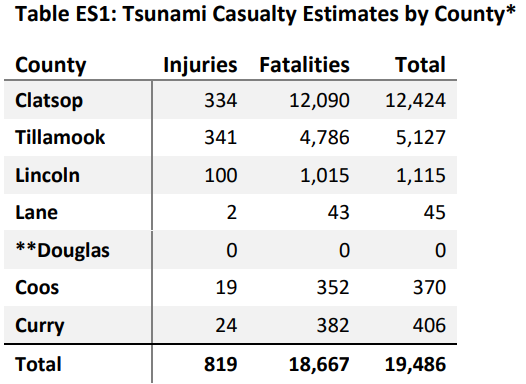
“A nearby earthquake could drop the low-lying regions of the coast several feet below sea level. The highest tsunami waves could reach 80 feet and severely flood coastal communities near beaches, bay mouths, and low-elevation coastal plains. Oregon’s at-risk population is approximately 40,000 on the outer coast, excluding tourists and visitors that seasonally swell the population manyfold.”

“New tsunami simulations indicate that the largest waves may run up to elevations twice as high as earlier models predicted and flooding may inundate hundreds of yards farther up coastal valleys.”
According to the Oregon Seismic and Safety Policy Advisory Council (OSSPAC), “A full 9.0 megathrust Cascadia earthquake and resulting tsunami will create an unprecedented magnitude of emergency need… Reaching impacted populations, many of whom will be isolated, will present a level of operational complexity our state and country have never seen before… We currently have low resilience and low capacity to provide for the enormous emergency response that will be needed to support those most highly-impacted by a Cascadia event… We are not prepared if a Cascadia event happens in the near future.”

“Of 5,350 state facilities evaluated in an earthquake hazard zone, 838 building were flagged as extensively or completely damaged following a CSZ event… totaling over $1.3 billion in potential damage to property. Among the 1,647 critical state facilities, 360 were flagged as extensively or completely damaged.”

“The 10 counties projected to incur the most loss and damage due to a CSZ earthquake (most to least): Multnomah, Lane, Coos, Washington, Marion, Benton, Lincoln, Josephine, Clatsop, and Jackson. Seaside is the most vulnerable coastal town.”

“90% of Oregon’s population of nearly 4 million people will be directly affected by a Cascadia earthquake and tsunami.”
“This event is predicted to destroy transportation and fuel infrastructure across the Pacific Northwest, cost Oregon more than $30 billion in direct and economic losses, and result in anywhere from 1,250 to more than 10,000 deaths.”

This system allows users to view landslide and liquefaction risks, expected shaking intensities, active faults and more. You can zoom in much more than the images below allow.


Check out this website to generate address-specific reports like the one shown here. Run it for your home, place of business, child’s school, etc.
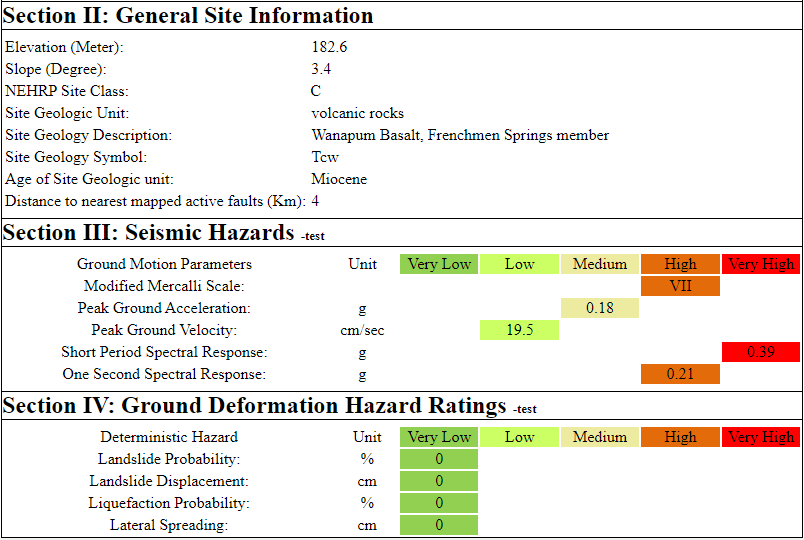
If you click the hyperlink above, you’ll be able to view and download detailed maps (examples shown below) of Oregon with overlays for Peak Ground Velocity, Probability of Liquefaction, Peak Ground Deformation, tsunami inundation, and more.
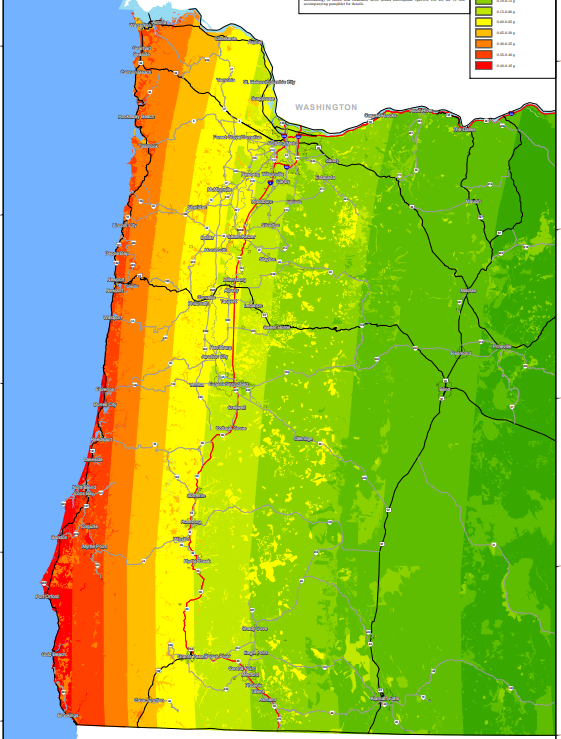
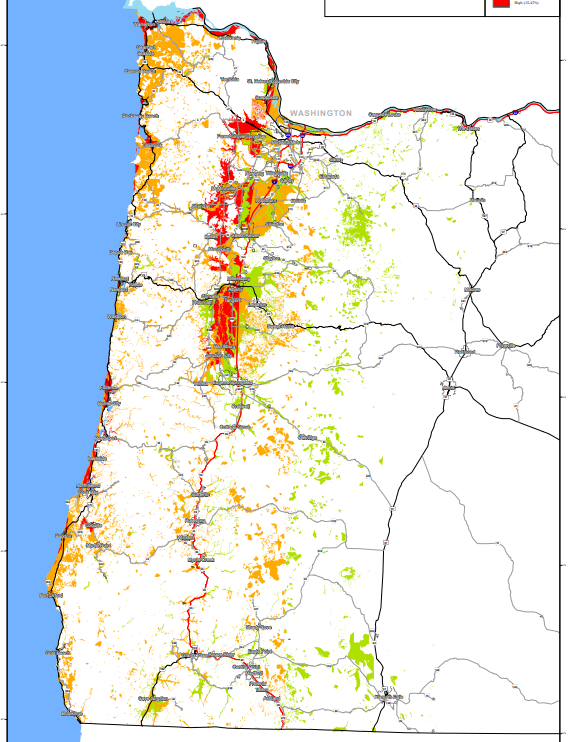
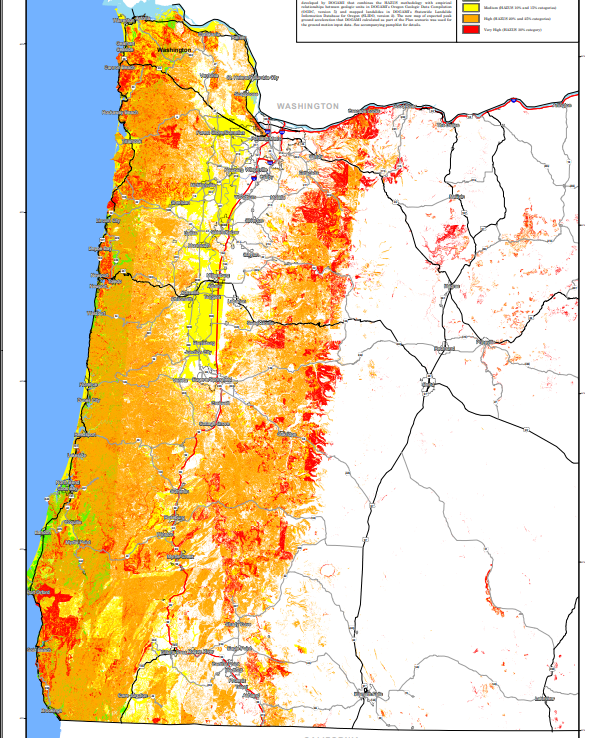
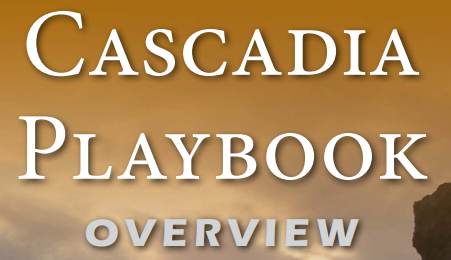
| Ground shaking: 4 – 6 minutes |
| Tsunami reaches coast: as little as 15 minutes after shaking |
| Damaged structures: 10,000+ |
| People in need of shelter: 10,000+ |
| Economic losses: $50+ billion |
| Fatalities from earthquake and tsunami: ≈25,000 |
